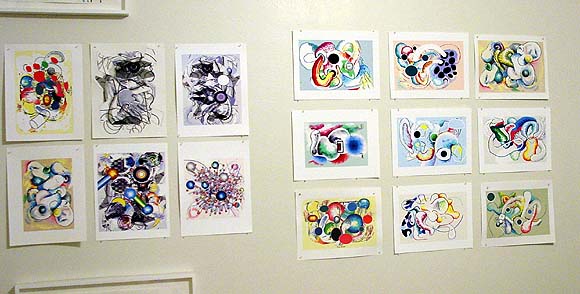View current page
...more recent posts

Working on presentation of these wormy vortex drawings. The physical, printing-and-display part is boring. Most of these are test prints, eventually they'll all be on Epson's 100% rag paper, which is a neutral surface, surprisingly not arty-looking at all. And framed like the pieces cropped at the top and bottom of the photo. (Computer work done in an ordinary program like MSPaint or Paintbrush becomes more problematic when you treat it like a sacred museum object, I swear it's not just for retail reasons. Evidence of a certain financial commitment to what's perceived to be cultural ephemera. Plus they just look more embodied, and therefore more interesting in person.) After printing a couple I noticed the inked outlines were mushy--not crisp like they're supposed to be. Was it the ink bleeding into the rag paper? No, my new-ish printer defaults to "edge smoothing." I can't believe I just realized this. Drawings done in pixel-y programs should have sharply pixeled edges, so they look like what's on the screen. Edge smoothing gives everything that "resampled in Photoshop" look--ugh. Not acceptable.
"93 in the House" [mp3 removed]. This is a straight-up, old school house tune I've been working for a few days. The basses and pads are familiar sounds of yesteryear but the rhythms use fairly up to date digital methods, such as NI's "spektral delay," which spectrally analyzes the beat and rearranges it to create echoes with varying attack curves. The drums mix samples and live synthesis. The tunes I wrote, trying to stay "in period." Those who may have followed these music posts of the past year will note the first use of a bridge and two dropouts.
Here are eight of the "25 Questions Regarding the Murder of New Orleans" currently posed online in The Nation by Mike Davis and Anthony Fontenat. The locals they interviewed are certainly asking these even if the rest of us aren't. To tweak the line from the '60s, "just because you're paranoid doesn't mean people aren't trying to kill you and steal your land." Some straightforward answers now could stanch conspiracy theories later on:
1. Why did the floodwalls along the 17th Street Canal only break on the New Orleans side and not on the Metairie side? Was this the result of neglect and poor maintenance by New Orleans authorities?
2. Who owned the huge barge that was catapulted through the wall of the Industrial Canal, killing hundreds in the Lower Ninth Ward--the most deadly hit-and-run accident in US history?
3. All of New Orleans and St. Bernard Parish east of the Industrial Canal were drowned, except for the Almonaster-Michoud Industrial District along Chef Menteur Highway. Why was industrial land apparently protected by stronger levees than nearby residential neighborhoods?
9. Why were the more than 350 buses of the New Orleans Regional Transportation Authority--eventually flooded where they were parked--not mobilized to evacuate infirm, poor and car-less residents?
10. What significance attaches to the fact that the chair of the Transportation Authority, appointed by Mayor Nagin, is Jimmy Reiss, the wealthy leader of the New Orleans Business Council, which has long advocated a thorough redevelopment of (and cleanup of crime in) the city?
11. Under what authority did Mayor Nagin meet confidentially in Dallas with the "forty thieves"--white business leaders led by Reiss--reportedly to discuss the triaging of poorer black areas and a corporate-led master plan for rebuilding the city?
19. Is the Justice Department investigating the Jim Crow-like response of the suburban Gretna police, who turned back hundreds of desperate New Orleans citizens trying to walk across the Mississippi River Bridge--an image reminiscent of Selma in 1965?
20. Who is responsible for the suspicious fires that have swept the city? Why have so many fires occurred in blue-collar areas that have long been targets of proposed gentrification, such as the Section 8 homes on Constance Street in the Lower Garden District or the wharfs along the river in Bywater?
[via]
